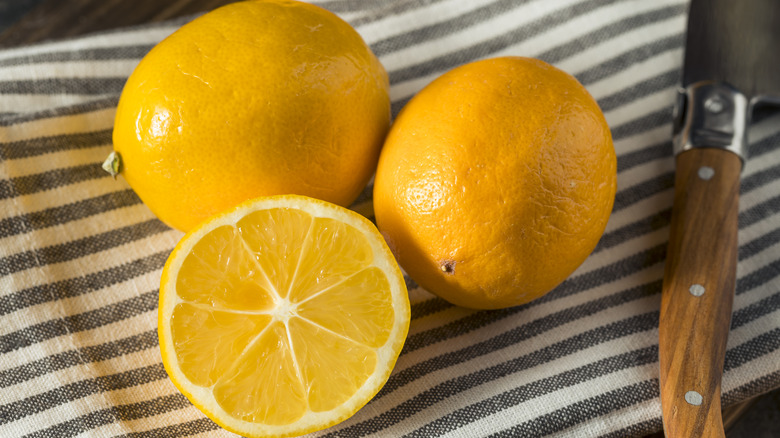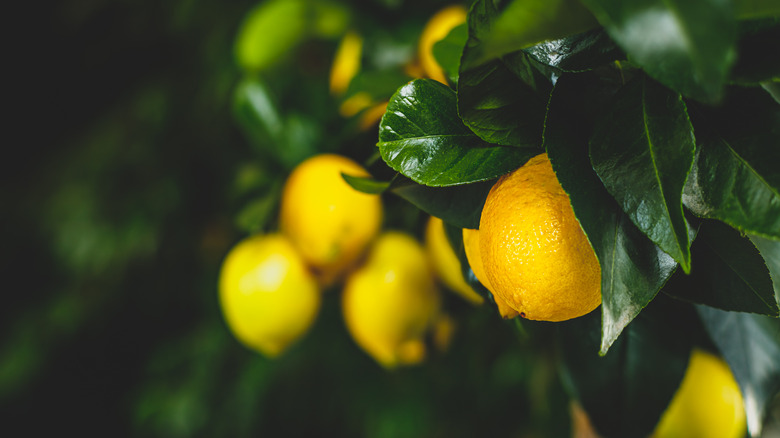The Flavor Profile That Sets Meyer Lemons Apart
Meyer lemons are the darling of the citrus world. Lovely to look at and delightful on the palate, they're prized for both their appearance and taste by many in the culinary world. Unlike knobby and oblong versions of yellow lemons, such as the classic Eureka or Lisbon varieties, Meyers are round and smooth with a rind that ranges from deep golden yellow to honeyed orange in color, almost like the hue of an egg yolk. Underneath the very thin white pith lies juicy and just as colorful flesh.
For as pretty as they look, the flavor profile of Meyer lemons is what really sets them apart. They have a complex sweetness and a delectable herbaceous quality. Though they do still have a pleasant level of acidity, Meyer lemons lack the characteristic lip-pickering, sour bite of more traditional citrus. And their aroma adds another dimension to the sensory experience, offering notes that are prominently floral and spicy.
What is a Meyer lemon anyway?
The Meyer lemon is more than likely a natural cross between a standard lemon and a mandarin orange and belongs to the Rutaceae family. Meyer lemons hail from China where they've long been used as an aromatic, ornamental, evergreen plant. They were brought to the United States only in the early 1900s by Frank Meyer, an agricultural explorer for the Department of Agriculture.
Meyer lemons were not widely used until the 1970s, and before that, they were almost completely destroyed because many trees carried the tristeza virus. Though Meyer plants were asymptomatic, other citrus varieties that grew around them were not, and the spread of the tristeza virus early on put the California citrus industry in a deeply precarious situation. In fact, in the '40s, nearly all of the stock of Meyer lemons was preventatively destroyed to contain the spread.
A clone was eventually made from an immune strain, creatively called the "Improved Meyer lemon" or Citrus x meyeri, ensuring the fruit could live on, though the fruit's reputation was understandably affected. Meyer lemons were really only popularized when famed chef Alice Waters started cooking with them. She gathered some from around her California-based restaurant, Chez Panisse, and went on to use them regularly. Martha Stewart is another prominent figure that helped put Meyer lemons back on the map, highlighting them in recipes and even planting some trees in her home garden.
Best ways to use Meyer lemons
You might not be able to find Meyer lemons regularly at your standard supermarket, though they may be available at specialty markets and farmers markets in December through May, when they are in season. Their very thin skin makes them susceptible to damage during transport, so they are not commercially produced. Because of this, you are likely to find Meyer lemons most easily in citrus-growing regions, though you can also buy them online.
Once you get your hands on some Meyer lemons, the possibilities are endless. Not only are the juice and flesh delicious, the whole fruit is actually edible, besides the seeds. But, both the rind and zest are thin enough to eat in their entirety.
You can thinly slice fresh Meyer lemons, rind and all, and toss with arugula, goat cheese, and toasted pistachios, and dress with some lemon juice and white balsamic vinegar for a fresh salad. Or, wrap salmon, fresh fennel, and Meyer lemon slices in parchment paper, or en papillote, and bake for a delicate main dish. And, don't forget dessert! Let this sweet, tart fruit really shine in a lemon tart or in a classic lemon curd. Really, you can use Meyer lemons in any sweet or savory preparation where you would use a regular lemon for a sweeter, less acidic twist.



